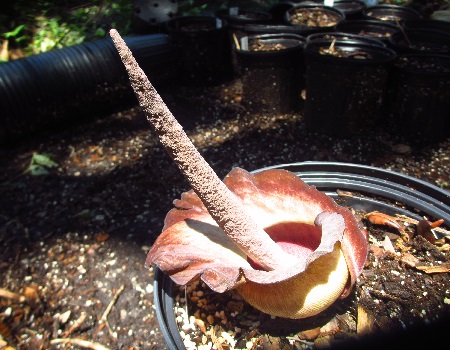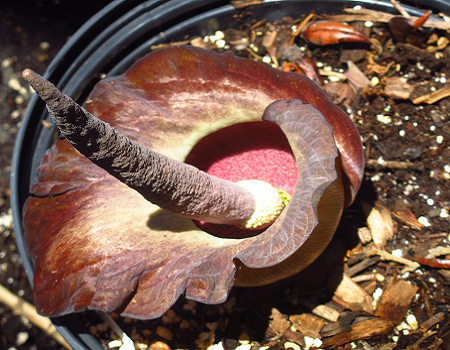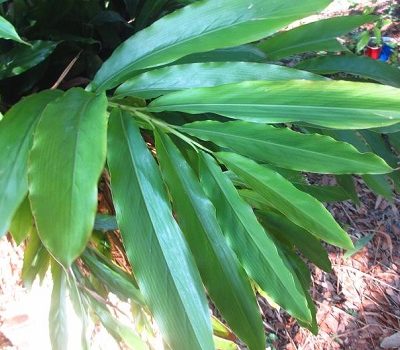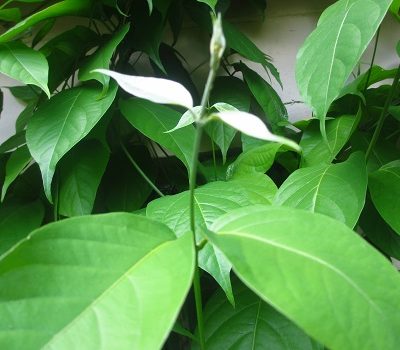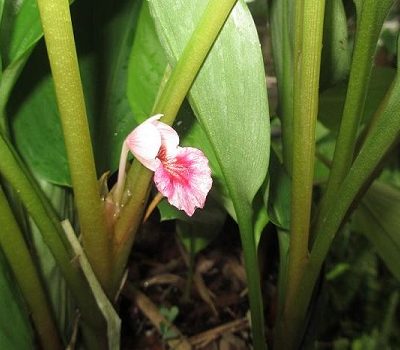Amorphophallus impressus is from Malawi. There is very little information about this species, but they don’t differ from other species in their care or growing.
I particularly like the spittoon shaped flowers on this species. Like all Amorphophallus, the flowers are pollinated by carion beetles, not by bees, so the fragrance smells like decaying flesh. Many people are freaked out by this. Personally I think it’s cool. Not all flowers should smell like unicorn farts.
The tubers should be planted in Spring once all chance of freezing temperatures are past. Do not transplant it while it is growing. The tuber should be planted in the pot it will be staying in for the whole growing season. In Fall, the leaf will fall over, and turn yellow. After that, you can dig up the tuber and store it in a paper bag until the following Spring. If you live in a mild enough climate, you can leave the tuber in the soil, but it must remain dry while it is dormant or it will rot.
Origin
Africa, Malawi
Family
Araceae
Binomial nomenclature
Amorphophallus impressus
Common names
None
Description
LEAF solitary, c. 120 cm long; petiole c. 100 cm long, c. 2.5 cm in diameter at the base, green with purple spots; lamina green, c. 100 cm in diameter, rhachises with broad-triangular to oval wings, terminal leaflets elongate-oval, 4-10 7 1-3 cm, acuminate, margin slightly undulate or dentate. INFLORESCENCE: Cataphylls 2(-4), the outer one 10-14 cm long, the inner most 25-30 cm long, longer than spathe and peduncle together, whitish to pink and with greenish to brownish oval to roundish spots. Inflorescence sessile, appearing before the leaf, short-peduncled, c. 50-70 cm long; peduncle 5-10 cm long, 1-1.5 cm in diameter, smooth, brown-green with or without green or olive spots, to the spathe grading into purple. Spathe 12-25 cm long, separated by a strong constriction in a depressed, urceolate tube and a rimshaped to elongate-triangular limb; tube 3.5-10 7 4-9 cm, outside creamy to flesh-coloured, the lower part greyish brownish to green, with dark green veins and small green to brown spots; inside pinkish, purple to reddish brown, lower part with small, tongue-shaped colourless or purple or reddish brown emergences of 0.3-1 7 0.5 mm higher up reduced in size and causing the inside surface to be rough; limb strongly undulate, on the side of the longest cataphyll 4-6 cm long, on the other side elongate-triangular and 6-15 cm long, outside dark green to brownish purple, with thick purple veins, inside pink to purple, margin maroon. Spadix sessile or stipitate for 1-6 mm, 18-40 cm long, longer than spathe; pistillate zone cylindrical, 1-3 7 0.8-1.2 cm, flowers congested or somewhat distant; staminate zone obconical to ovoid, narrowed at base, 1.5-4 7 1-3 cm, flowers congested; sterile zone between pistillate and staminate zone 1-10 mm long; appendix 20-35 cm long, thick-conical to slightly clavate, above the staminate zone slightly constricted, 2-4 cm in diameter at the base, dark purple, verruculose; staminodes absent; ratio of pistillate to staminate zone length 0.4-0.6 : 1. Pistillate flowers 2-4 mm long; ovaries globose-ovoid, 1.5-2 7 1.5-2 mm, yellowish green or bright green, (1-)2(-3)-locular, stigma sessile, 1-2 7 1-2 mm, dark yellow, papillose, with 2(-3) small roundish humps or rarely roundish and smooth. Staminate flowers 0.9-1.6 7 1-1.9 mm, with 2-5 stamens; filaments absent or only 0.1-0.2 mm long; anthers free, elongate-ovoid to cubic, creamy to yellowish orange; connective with two small grooves, brown; pores elongate-oval, one apical to subapical pore per theca (rarely two pores per theca). Pollen inaperturate, exine smooth (psilate).
(description taken from kew gardens website)
Height
3′ tall.
Temperature/Zone
zone 9b, 32°F. This plant prefers humid conditions. It goes dormant in Winter. The tubers can be dug up and Wintered in a paper bag, anywhere in the USA.
Light
Part sun to shade.
Water
Keep them evenly hydrated while they are growing, but allow them to dry out completely while they are dormant. If they are too wet while they are dormant they can rot.
Fertilizer
It is important to supply them with phosphorus. Phosphorus is what allows them to grow a larger tuber. Since they grow a new tuber each year, this is largely what determines the size of the plant in the following year. Just as I do for gingers, I use a 1/4 strength liquid fertilizer, formulated for tomatoes on these.
Cultivation
Plant the tuber in very rich, well draining soil. Give them a good amount of root space. Plant it in the pot it will be in for the whole season. You should not transplant them while they are growing. I’ve done it, but it is best not to disturb their roots once they are growing. If the leaf petiole is broken or badly damaged during transplantation it will often cause them to die. It is for this reason that I don’t ship them while they are growing. This species grows many, long stoloniferous offshoots, which makes the tuber look like an octopus when you dig them up. Each stolon can be broken off and grown as a new plant, making it very easy to propagate theis species quickly.
Pests
I have not found any pests to be a problem for this plant in Florida.

